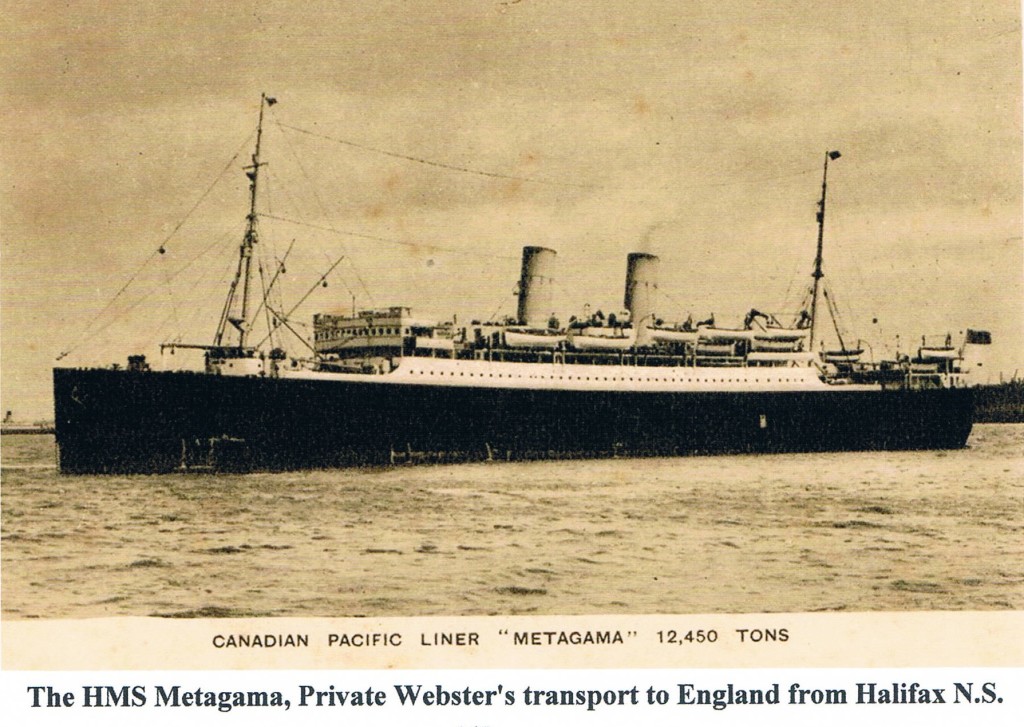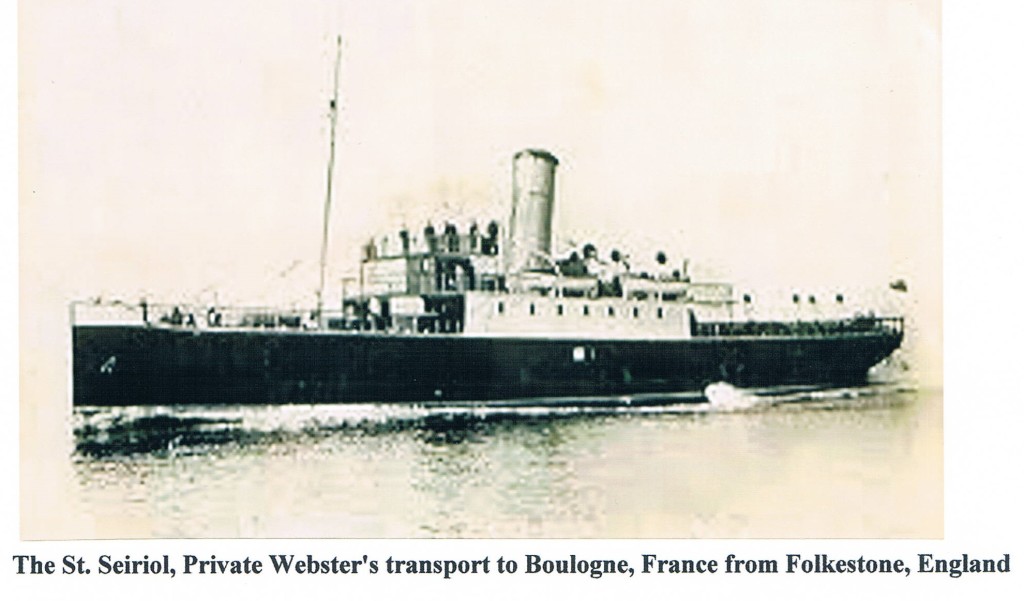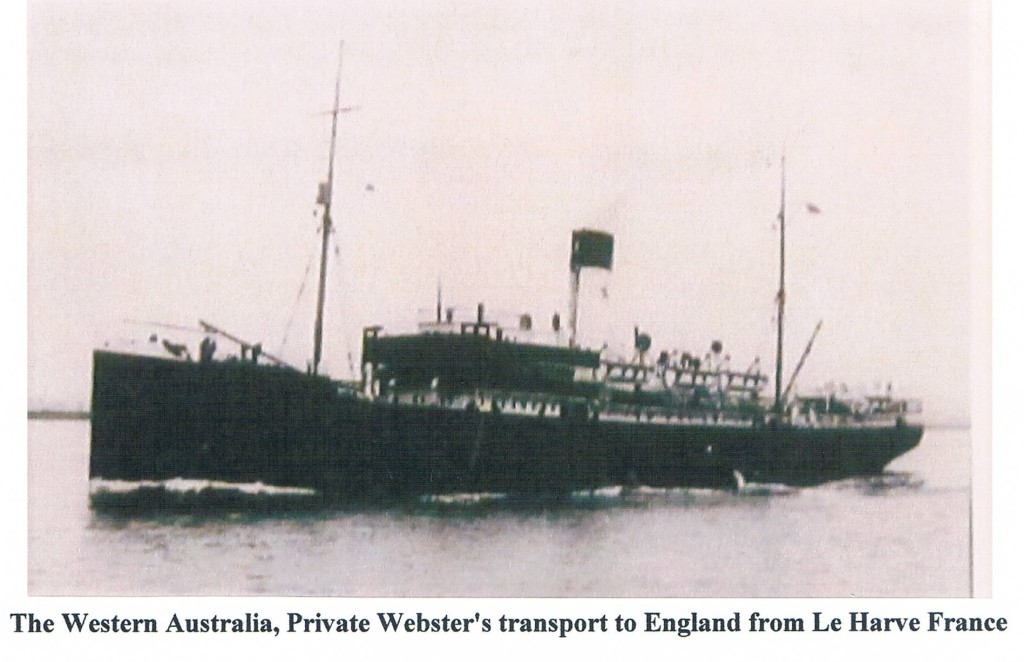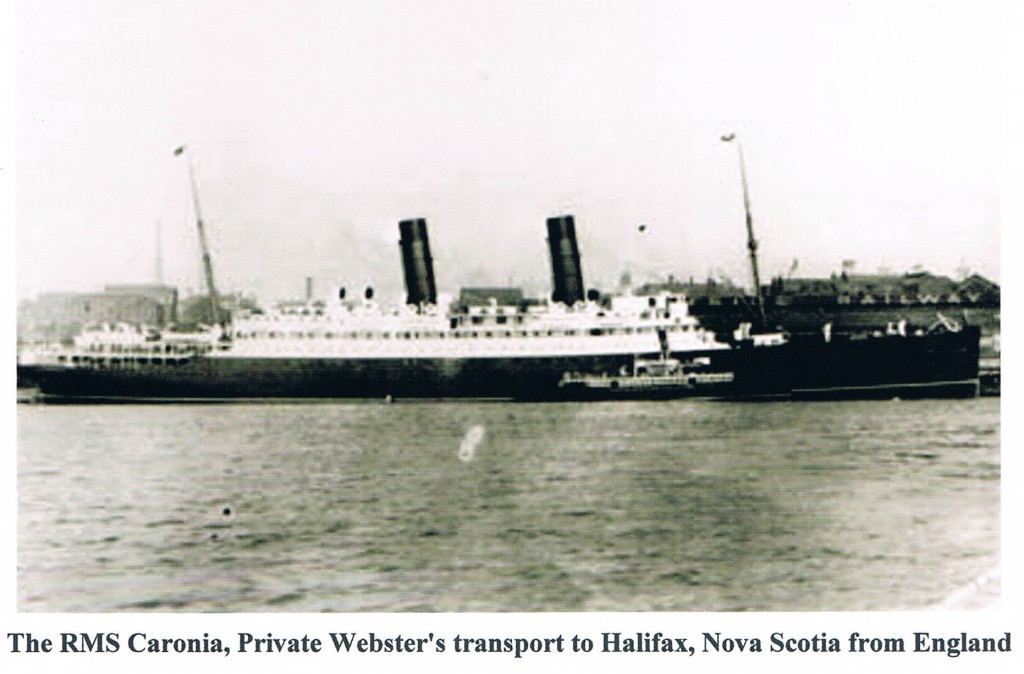
MILITARY HISTORY
Private W. L. Webster: Service Number 60037 — ACTIVE SERVICE (World War I)
Wilbert Lawrence Webster had Active Militia experience by serving with the East Durham 46th Regiment and the 14th Princess of Wales Own Regiment prior to enlisting in the Active Service in 1914. On November 9, 1914 Wilbert Lawrence volunteered for service with the CEF at Kingston, Ontario. He was a single man when, on the November 11, 1914, he enlisted in Kingston Ontario for the duration of the War, with the Canadian Over‑Seas Expeditionary Force (CEF). He gave his birth‑date as April 10, 1896 (actual date is April 10, 1897) which appeared to make him 18 years, 7 months old and that he was born in Lanark Ontario. This age would meet the minimum requirement of 18 years old. He listed his employment as “chauffeur” and gave his next-of-kin as his mother, Mrs. W. J. Webster of Lakefield. At the time Wilbert Lawrence was 5′ 6″ tall, 35″ chest, brown hair and brown eyes. He entered as a Private with service number 60037 and was assigned to “G” Company, 21st Infantry Battalion, CEF; a Unit with the 2nd Canadian Division, 4th Infantry Brigade. “G” Company was later reorganized into “D” Company; Private Webster was employed as a Scout.
Private Webster’s records do not indicate what he did or where he was from November 11, 1914 until he embarked from Halifax, Nova Scotia for England six months later, about May 5, 1915. He would have been involved in Basic and Advanced Training as an Infantry Soldier. This would include drill, deportment, weapons, grenades, gas warfare, offensive and defensive tactics, bayonet drill plus other military requirements. On May 6, 1914 Private Webster embarked the HMS Metagama at Montrèal, Quèbec. He disembarked at Devonport England May 15, 1915 and proceeded to the West Sandling Camp, near Hythe Kent. Private Webster was in West Sandling August 1915; then, on September 14, 1915 he embarked the St. Seiriol at Folkestone England and September 15, 1915 he disembarked at Boulogne France and proceeded to St. Omer. In addition to his duties as a Scout, Private Webster was also employed as a Sniper’s Spotter. On September 15, 1916 the offensive which was to be known as the Battle of Flers-Courcelette, part of the Somme Offensive, was launched on a wide front and involved the first use of tanks.


During the attack at the Sugar Factory at Courcelette, Private Webster was in an advantageous position in a tree scouting the area when a shell exploded close to his position. The effects of the blast threw him out of the tree and into a shell hole which quickly filled with the material from the explosion. Private Webster was almost totally buried and had to rely on help to get loose from his near burial. The ordeal damaged one of his kidneys but there is no mention of this event in his records. (Note: Surgery, circa 1950, removed the damaged kidney). As related by his son John Lawrence, Pte Webster entered a captured German bunker at Courcelette and later emerged wearing a German uniform and surrendered as a Prisoner of War. He obviously had quite a sense of humour in a very trying time. On September 29, 1916, during an attack at the Regina and Courcelette Trenches, Private Webster suffered a shrapnel wound to his right ear and was admitted to No 5 Canadian Field Ambulance (CFA) . On October 2, 1916 Private Webster transferred to No 9 CFA for administration and was discharged back to his Unit fit for duty. October 10, 1916 Private Webster transferred to the 21st Battalion fit for duty from the Hospital. December 6, 1916 Private Webster was granted 10 days leave and December 22, 1916 he was back on duty from his leave.
On January 7, 1917 Private Webster had been put on a one-week Course at the Division 1 School (in the Field). January 13, 1917 he returned to duty from the Division 1 Course, after this, on February 14, 1917 he was attached to the 4th Canadian Infantry Brigade (CIB) as a Scout. On August 24, 1917 he was admitted to No 10 CFA for a 16 day stay due to phlebitis. He was discharged to the Eastern Ontario Regimental Depot (EORD) on September 8, 1917. On October 13, 1917 he was admitted to No 6 CFA and on October 14, 1917 he was transferred to No 22 Casualty Clearing Station (CCS) both due to pyrexia (fever) of unknown origin (PUO). Private Webster was then admitted to No 56 General Hospital, Étaples France via the No 6 Ambulance Train (AT) on October 17, 1917. On October 25, 1917 he transferred to No 6 Convalescent Depot (CD). On October 28, 1917, he transferred to No 3 CD at Le Tréport, France still with a fever. He was discharged from No 3 CD on November 4, 1917 and taken on strength on November 5, 1917 with No 2 Canadian Infantry Brigade Depot (CIBD) at Étaples, France and assigned to “A” Company for those recovering from wounds and illness. On November 8, 1917 Private Webster left No 2 CIBD and joined the Canadian Corps Reinforcement Camp (CCRC) at Calonne Ricouart.
On November 9, 1917 he left CCRC to rejoin the 21st Battalion in the Field and he rejoined them at Camblain L’Abbe on November 19, 1917. The delay in joining the Battalion was because of the heavy fighting at Passchendaele and the reinforcements were held up at Poperinghe waiting for the Battalion to come out of the fighting.
December 5, 1917 Private Webster was attached to the 4th Canadian Infantry Brigade. On November 9, 1918 Private Webster was wounded again (no details provided however this incident may have resulted in a scar above his right eye). December 13, 1918 the 21st Battalion marched across the Bonn Bridge as the first Allied Battalion to enter Germany as a Unit to form the Occupied Force following the War. December 20, 1918 he was granted 14 days leave. On April 3, 1919 Private Webster embarked the Western Australia at Le Harve France. He disembarked April 4, 1919 in England and proceeded to Witley Camp. April 7, 1919 he was taken on strength with P Wing, Casualty Clearing Centre (CCC) Witley, from the 21st Battalion, pending return to Canada.

On May 13, 1919 Pte Webster sailed out of Liverpool, on the HMS Caronia, for Canada and disembarked May 22, 1919 at Halifax, Nova Scotia and proceeded by train to Kingston Ontario. Private Webster was discharged on demobilization May 24, 1919 at the Kingston Ontario Dispersal Station.
At the time of his discharge he was 5′ 8″ tall and 22 years old (his correct age); he also had a scar on his forehead (above the right eye) and another on his right ear as a result of being wounded in September 1916 and November 1918. On discharge he was issued the Class “A” War Service Badge for service at the Front; number 279727. Private Webster related to his family that he was one of many soldiers who had to lead in front of British tanks clearing the wounded from any harm. Private Webster was a Scout and a Sniper’s Spotter. He would find lofty perches in trees and from good vantage points and draw a sketch of the terrain and the features which was then used by the Headquarters, including Snipers. In this type of work he would often be in the company of Snipers. There is no mention of Private Webster being a Scout in his military records, however, this is not uncommon as often this was classified information.
According to his military records; Private Wilbert Lawrence Webster earned the following medals which were sent to him at a later date:
The 1914‑15 Star;
The British War Medal; and
The Victory Medal.
He was also awarded War Service Badge – CEF Class “A”.

The 21st Battalion of the 4th Infantry Brigade, 2nd Canadian Division:
The 4th Brigade personnel were brigaded, as far as possible, territorially. The 18th, 19th, 20th & 21st Battalions were all mobilized in Ontario. The 21st Bn was involved in the following engagements: ST. ELOI CRATERS ‑ Craters 2 & 3 (April 8 ‑10, 1916) plus another two weeks of fighting; SOMME ‑ Courcelette (September 15, 1916); VIMY RIDGE ‑ Lens‑Bethune railway area (January 17, 1917) and Les Tilleuls (April 9, 1917); HILL 70 ‑ Chicory Trench (August 15, 1917); PASSCHENDAELE ‑ Aloof Trench (March 4, 1918); AMIENS ‑ Marcelcave (August 8, 1918) and HINDENBURG LINE TO CAMBRAI ‑ “The Battle Of The Scarpe” Guemappe/Monchy (August 26, 1918).
An excerpt from an article in McLean’s magazine by Barbara Amiel, September 1996:
The military is the single calling in the world with job specifications that include a commitment to die for your nation. What could be more honorable?
NOTE
The picture of the Western Australia ship and a number of items of information are all courtesy of the 21st Battalion website http://www.21stbattalion.ca, many thanks to Al Lloyd.
Lieutenant W. L. Webster: Service Number 16975 — ACTIVE SERVICE (World War II)
When Wilbert Lawrence Webster enlisted in the Canadian Active Service Force (CASF) {in Dundas, Ontario} on the November 13, 1940 as a Lieutenant (Lt) with Service Number 16975. Lt Webster was 43 years old, a member of the Church of England, and gave his occupation as an “Electrical Automatic Control Expert”. He gave his next-of-kin as his wife, Gwendolyn Webster of 117 Park St., Dundas Ontario. He indicated that he had served with the 102nd Field Battery Non‑Permanent Active Militia (NPAM) and at the time was a Lieutenant (as of January 2, 1933) and, of course, had served in the First World War (WW 1) from November 9, 1914 to May 24, 1919 with the 21st Battalion (Bn), Princess of Wales Own Regiment, CEF. His WW I Service Number was 60037.
Lt Webster requested appointment to the 1st Bn Lincoln and Welland Regiment (Regt), CASF as a Platoon Officer. He was appointed to the 1st Rifle Company, No 2 Military District (MD), Niagara Camp, on November 13, 1940. From there he moved to No 11 Military District (MD), Vancouver Camp, on May 12, 1941. Lt Webster then moved back to No 2 MD and subsequently was struck‑off‑strength (SOS) from the Lincoln and Welland Regtiment on September 10, 1941. Following this he was taken‑on‑strength (TOS) to No 2 District Depot (DD), Toronto on September 11, 1941 and then to A
No 11 Infantry (Active) Training Centre [I(A)TC], Borden Ontario on September 24, 1941.
On December 4, 1941 Lt Webster ceased to be attached to the Lincoln & Welland Regiment on being posted to the Home War Establishment (HWE), A No 11 I(A)TC, Borden Ontario from No 2 DD. On May 25, 1942 he took his release from No 2 DD, Toronto Ontario, and returned to his Reserve Status. Over this 18 month period he had achieved qualification on a Vickers Machine Gun Course, a Light Machine Gun Course and Driver Motorcycle (M/C) [January 5, 1942]. He also qualified as Driver (Wheeled & Track) III.
While no reason was given for Lt Webster to retire from the CASF, perhaps he was deemed “too old” (45 years old) to be deployed overseas.
Lt Wilbert Lawrence Webster was presented the following medals:
The Canadian Volunteer Service Medal; and
The War Medal 1939‑45.
He was also awarded War Service Badge – Army Class “B”.
In 1932 Wilbert Lawrence Webster was awarded the Colonial Auxiliary Forces Long Service Medal.
An excerpt from an article in McLean’s magazine by Barbara Amiel, September 1996:
The military is the single calling in the world with job specifications that include a commitment to die for your nation. What could be more honorable?
PERSONAL HISTORY
WILBERT LAWRENCE WEBSTER
Wilbert Lawrence was born April 10, 1897 in Lanark, Ontario one of 10 children born to Ida Caroline and Wilbert James Webster. Wilbert Lawrence had some misfortune as a young child. In one instant a dish of boiling water was accidently spilled over his head. The second accident occurred when he fell off a wagon which was traveling along the road and was run over. Fortunately he recovered from both events. He was given the nickname “Squib”, the same nickname that his father had earned.
The family moved to Lakefield, Ontario in 1904 and Squib remained there until he was about 6 weeks shy of his 13th birthday. Then on February 28, 1910 he left for Fenelon Falls to stay with his 1st cousin Samuel Wesley Pogue & his wife Mary Ada. He worked for his cousin who had a car dealership. It was here that Squib learned how to drive a car which was quite rare in those days.
Although Squib returned home for a number of visits, he remained in Fenelon Falls until the time that he enlisted with the Canadian Expeditionary Force on November 11, 1914. Prior to enlisting Squib had Active Militia experience by serving with the East Durham Battalion of Infantry, 46th Regiment.
After his discharge on May 24, 1919, due to demobilization, Squib returned to Lakefield where he became a member of the Lakefield Volunteer Fire Brigade, became a member of the Lakefield Citizens’ Band and partook in the sports and life of the Community. In 1921 he became the Lakefield Fire Chief and was lauded for his excellent work in making maps and pushing for the acquisition of a Siren Fire Alarm.
On May 11, 1925 Squib resigned his position as Fire Chief due to the fact that he was leaving to take a job with the Kaustine Firm in Dundas Ontario. Even prior to his departure he had been advertising the Kaustine “Odorless” chemical toilet system. Although he moved a number of times he remained in the Dundas area. Squib went on to invent many pumps and other innovative items.
On June 21, 1927 Squib married Gwendolyn Doreen Simpson in Toronto, Ontario. Gwendolyn lived in Lakefield, a daughter of William Albert & Julietta Simpson, and undoubtedly met Squib there. They had two daughters, Barbara Gwendolyn Julia, born July 20, 1930 and Patricia Marguerite, born May 7, 1935 and a son John Lawrence, born December 9, 1937. The family rented a cottage on the Trent River at the back-canal (outside Havelock). Some years later John purchased a lot [250 Cedar Shores Drive] and built a cottage. Later, he transformed the cottage into a permanent home.
Wilbert Lawrence (Squib) Webster died November 16, 1974 in Dundas Ontario and is interred in Hillside Cemetery, Lakefield with his wife Gwen.
THE WILBERT LAWRENCE WEBSTER FAMILY OF LAKEFIELD
Wilbert Lawrence’s grandfather, Charles Daniel Webster was born about 1821 in New York State, USA, died February 19, 1870 in New York State, USA. On January 9, 1856 he married Amelia Margaret Mitchell, born May 12 1832, in Omemee, Ontario. Amelia died October 22, 1906 in Beaverton, Ontario. Charles and Amelia had 8 children: Samuel Charles married Margaret Saul; Ann Elizabeth married William Jasper Long; Thomas Zachariah married Mary Thornton Magee; Emily Isabel married John Joseph Pogue; Lucinda died as an infant; Margaret Lucinda married Richard Briggs; Robert Frederick married Mary Ann Duncan and Wilbert James married Ida Caroline Mason.
Wilbert Lawrence’s father, Wilbert James Webster was born February 16, 1866 in Canada West, Omemee and died August 05, 1935 in Lakefield Ontario. On February 22, 1888 he married Ida Caroline Mason, born December 12, 1869 in West Durham County, Township of Cartwright, in Lakefield. Ida died March 11, 1960, in Lakefield Ontario. Wilbert and Ida lived in Lakefield; on February 10, 1889 they had a daughter, Violet Rossetta, who died 7 months later. About April 1891 Wilbert and Ida moved to Lanark, Ontario to open a Bakery & Confectionery business (Wilbert had experience working with his brother Thomas Zachariah’s Bakery & Confectionery Shop in Lakefield). They had 8 children while living in Lanark. Wilbert; a baker, policeman and a mason, moved his family back to Lakefield in 1904 after living 14 years in Lanark, Ontario. Wilbert’s father was Charles Daniel Webster, born in the USA; his mother was Margaret Amelia Mitchell, born in Canada West, Omemee. Ida Caroline’s father was Thomas Allen Mason, born in England; her mother was Elizabeth Ann Smith, born in Canada West.
Wilbert and Ida had 10 children; five boys and five girls in the following order:
— Violet Rosetta, born February 10, 1889 in Lakefield – died at 7 month old;
— Laurel May, born Jun 30, 1891 in Lanark married Dudley Herburt Edwin Cornell Chads
— Wilbert Scott, born January 24, 1893 in Lanark – died at 2 month old;
— Walter Carl, born April 26, 1894 in Lanark – died at 5 month old;
— Minnie, born April 24, 1895 in Lanark; married Graham Clarence Bromley
— Wilbert Lawrence, born April 10, 1897 in Lanark; married Gwendolyn Doreen Simpson
— Arthur Earl, born April 17, 1899 in Lanark; married Kathleen Ann Traynor
— Evangeline, born March 01, 1901 in Lanark – died at 1 year, 6 weeks old;
— Charles Frederick, born June 25, 1903 in Lanark; married Loretta Pearl Chapelle, and
— Ida Caroline, born November 09, 1905 in Lakefield married George William Hutt.